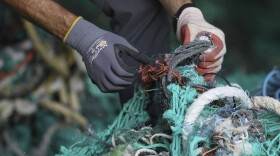The colorful paʻu riders are one of the most unique features of any parade here in the Hawaiian Islands. Draped in yards of brightly colored fabric and decked in lei, pa?? (pah-OOH) riders continue an old equestrian tradition. HPR Reporter Ku?uwehi Hiraishi has more.
“Keep your width and keep your distance. Thank you.”

Ronica Ann Ibarra shouts orders from the middle of a dusty grass field at Kahuku’s Gunstock Ranch.
"Sit up straight!" yells Ibarra.
The veteran pa?? rider is in customary paniolo or Hawaiian cowboy garb – tanned boots peeking out from her blue jeans; her long brown hair flowing from a cream colored cowboy hat.
“Good job. Good job. There you go," says Ibarra.

She perpetuates the Hawaiian tradition of pa?? riding. Pa?? means skirt in the Hawaiian language.
Traditionally, pa?? riders were female horseback riders known for wearing long, colorful skirts. Ibarra learned to ride when she became a pa?? rider nearly two decades.
“When you’re new, you don’t know what to do and the horse will just sit there cause its waiting for a command,” says Ibarra, “They say, ?the horse won’t go?. I said, ?yes, they will go. They’re just nervous.’ I said you need to relax cause they can feel you out if you’re tense you know?

For the past three months, she’s been training her team or pa?? unit to ride in the 72nd annual Aloha Festivals Floral Parade in Waikiki.Her seven-member unit will be draped mostly in purple to represent the island of Kaua?i. Four out of the seven members in her unit are new.
“In the beginning it was like really scary but exciting too,” says newbie Sandy Higa.
She and fellow rookie Reri Solatorio will ride just behind Ibarra in the parade.

“We just want to represent our island Kaua?i and just make everybody happy and show them the aloha spirit,” says Solatorio.
“Ok, Reri, you guys make a 'U' go around, come back around the other way...” shouts Ibarra.
“What are you looking for?” I ask.
“Their line. Make sure their line is straight, which it should be. The length between the horses,” answers Ibarra.

“What do the judges look for?” I ask.
“Horsemanship, number one,” says Ibarra, ”How the unit reacts to each other? Are you work as a unit? Then they have your flowers. They judge you on your flowers.”

Then there's the costumes, most of which Ibarra sews herself.
The equestrian tradition of pa?? riding dates back to the early 19th century when horses were introduced to Hawai?i and women of the chiefly class dressed up to ride for formal occassions. They began wearing long skirts to protect their legs while traveling.
Over time, the outfits became more elaborate.
“It is hot!” Ibarra admits.
She says one pa?? requires at least 12 yards of fabric. For comparison, a t-shirt requires just under three yards. Add to that multiple strands of lei and a sometimeshefty floral headpiece.
“How do you stay cool?” I ask.
“Think cool,” says Ibarra, “But its great when you get to do the kaheas (customary greeting) cause you get to lift up your arm and the air goes right through. Its like oh yes.”
So if you happen to find yourself at the Aloha Festivals parade this Saturday, remember that the beaming smiles accompanying the graceful waves are not just one of accomplishment but of sincere relief.




